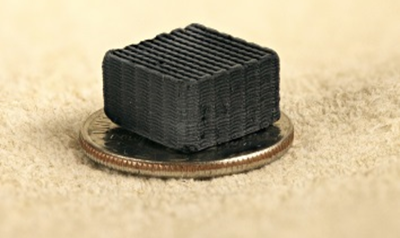Christopher Spadaccini (14-SI-004)
Abstract
Additive manufacturing—a breakthrough technology that is revolutionizing domestic and global manufacturing—creates the potential to engineer materials possessing desired structural, thermal, electrical, chemical, and photonic properties in a single package. While many types of additive manufacturing tools are commercially available, ranging from simple desktop thermoplastic printers to state-of-the-art laser powder-bed metal systems, there are still significant limitations. Some of these limitations include the ability to create components with mixtures of materials ranging from polymers to ceramics, metals, and semiconductors. Moreover, commercial platforms do not have the resolution to access unique and powerful physics at the microscale and the nanoscale. Our goal is to develop and thoroughly understand new design methodologies and manufacturing techniques that will enable us to produce specific multifunctional materials with mission-relevant applications ranging from stockpile stewardship to global security to nuclear fusion ignition. These material properties will be combinations of normally disparate physics such as unique structural properties combined with photonic functionality. To execute this ambitious goal, we will undertake two closely linked thrusts: inventing and developing new additive manufacturing processes and designing and characterizing multifunctional materials.
We expect to develop an understanding of the invention, development, and physical and chemical properties of new additive manufacturing processes, as well as advance the state of the art in design of material architectures. We will develop four new additive manufacturing tools: direct metal writing, diode-driven additive manufacturing, three-dimensional multiple-beam lithography, and massively parallel optical tweezing using a highly focused laser beam to hold and move microscopic dielectric objects. In addition, we will develop two methods for designing multifunctional materials: freedom-and-constraint topologies design and topology-optimized inverse design. Finally, we will design new multifunctional materials and produce them using our new additive manufacturing tools as well as tools developed previously at LLNL. The Laboratory's extensive capabilities in microscopy, nondestructive evaluation, chemical composition measurements, and mechanical testing will provide characterization of the materials performance, which will be fed back into the design process.
Mission Relevance
This project supports Livermore's missions in national security and energy security by developing techniques for manufacturing materials with applications in stockpile stewardship, energetic materials for defense uses, and materials for high-energy-density targets for fusion energy research. This project also aligns with LLNL's core competency in advanced materials and manufacturing.
FY15 Accomplishments and Results
In FY15 we (1) developed the capability to melt metals using diode laser arrays in our new diode-based additive manufacturing system, (2) developed the ability to extrude metal alloys such as bismuth–tin in our new direct metal-writing system, (3) designed and demonstrated initial functionality of a large parallel optical-tweezing system, (4) created a design for a holographic lithography system, (5) demonstrated the printing of graphene (a thin layer of pure carbon) aerogel (see figure), (6) characterized printed graphene aerogel showing multiple functionality—structural and electrical, and (7) succeeded in running the topology optimization code with electromagnetic properties.
Publications and Presentations
- Giera, B., et al., “Mesoscale particle-based model of electrophoresis.” J. Electrochem. Soc. 162(11), D3030 (2015). LLNL-JRNL-669534.
- Pascall, A. J., et al., “Light directed electrophoretic deposition for additive manufacturing: Spatially localized deposition control with photoconductive counter electrodes.” Key Eng. Mater. 654, 261 (2015). LLNL-JRNL-662724.
- Sullivan, K. T., et al.,"Controlling material reactivity using architecture." Adv. Mat. 28(10), 1934 (2015). LLNL-JRNL-654040.
- Sullivan, K. T., et al., "Quantifying dynamic processes in reactive materials: An extended burn tube test." Propell. Explos. Pyrotech. 40(3), 394 (2015). LLNL-JRNL-663731.
- Zheng, X., et al., “Lightweight micro lattices with nanoscale features fabricated from projection microstereolithography.” 2014 IEEE 27th Intl. Conf. Micro Electro Mechanical Systems (MEMS), p. 510. Institute of Electrical and Electronics Engineers, Piscataway, NJ (2014). LLNL-CONF-646856.
- Zhu, C., et al., “Highly compressible 3D periodic graphene aerogel microlattices.” Nat. Comm. 6(6962), doi:10.1038/ncomms7962 (2015). LLNL-JRNL-665510. http://dx.doi.org/10.1038/ncomms7962






